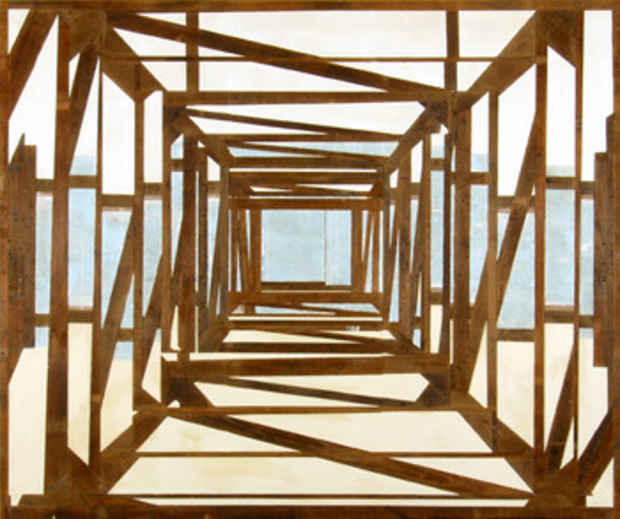Michael Zelehoski "Objecthood"
Kesting / Ray

This event has ended.
The gallery space is transformed with a series of found objects– including a picnic table and two ubiquitous police barricades– that have been disassembled and compressed into visually stunning, two-dimensional sculptures. Michael Zelehoski’s recent work involves the literal collapse of three-dimensional objects and structures into the two-dimensional picture plane. He begins by deconstructing the object, exploring spatial dimension as he cuts it into sometimes hundreds of abstract fragments. He then reassembles the pieces two-dimensionally and fills the negative spaces with carefully fitted pieces of wood, creating a solid plane in which the object is trapped in a parody of its former perspective.
As the process brings sculptural elements into the realm of painting, so it brings actual, quotidian objects into the realm of art. Zelehoski works almost exclusively with everyday objects, but by giving them autonomy and internal coherence, he is able to reveal their intrinsic value as art. The viewer is drawn to the compositional unity of the piece as well as the unitary object confronting them. A chair, for example, remains a chair, formally and materially, even as its function is negated. It is at once the aesthetic event, the representation and the object itself.
Zelehoski draws on Modernist explorations of spatial perception and representation. In his work we clearly see elements of collage and assemblage, and the influence readymades, objets trouvés and combines. However, Zelehoski’s work is firmly rooted in ideas associated with minimalism – although he often comes opposite conclusions – particularly the phenomenology of Maurice Merleau-Ponty. “The evidence of the perceived thing lies in its concrete aspect, in the very texture of its qualities and in the equivalence among all its sensible properties. Before our individual existence the world is true; it exists.” But, asserts Zelehoski, the world has no consciousness of itself. It is we who create a consciousness of reality through direct sensual knowledge.
Zelehoski’s work also deals with psychogeography– the idea that our experience is shaped through our interactions with the physical world – by distilling ephemeral objects into works that transcend time and space. This overlaps with the gallery’s mission to present work dealing with contemporary psychogeography.
[Image: Michael Zelehoski "Tower" (2008) mixed media assemblage with found wood 46 × 55 in.]
Media
Schedule
from September 09, 2010 to October 10, 2010
Opening Reception on 2010-09-09 from 19:00 to 21:00